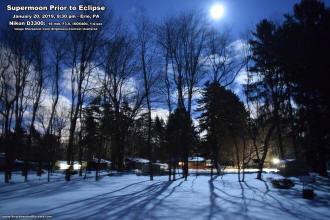|
 January's first full moon, known as the
Wolf Moon, is the biggest and brightest full moon of 2019 -
a 'supermoon' in modern parlance. It was also a long duration (1 hour and 2 minutes)
total lunar
eclipse. The technical name for this special combination is the perigee-syzygy
of the Earth-Moon-Sun system. The moon reached fullness at 00:16 EST and perigee at
14:59 EST on the 21st. The moon is full when the earth is between the sun and
the moon, and the moon is new when it is between the sun and Earth. January's first full moon, known as the
Wolf Moon, is the biggest and brightest full moon of 2019 -
a 'supermoon' in modern parlance. It was also a long duration (1 hour and 2 minutes)
total lunar
eclipse. The technical name for this special combination is the perigee-syzygy
of the Earth-Moon-Sun system. The moon reached fullness at 00:16 EST and perigee at
14:59 EST on the 21st. The moon is full when the earth is between the sun and
the moon, and the moon is new when it is between the sun and Earth.
The picture below was taken out of my back door, at around 9:30 pm local time
(Erie, PA), at the beginning of the penumbral phase of the eclipse (not apparent
in the photo). The outside temperature was about 5 °F and the wind was howling
pretty good - quite appropriate for this Wolf Moon!
Because of widespread cloud cover, I had to wait a while to get an unobstructed
shot of the moon. By the time the total phase began at 11:41 pm, the sky was completely
overcast. I dread the statistical likelihood of overcast skies when on
April 8, 2024, the path of totality for North America's next
total solar eclipse of runs right through my yard.
An off-the-shelf Nikon D3300 camera with an 18 mm lens was used on the Auto
setting resulting in a 1/4-second exposure at F3.5, ISO6400. The photo was
sharpened a little, but the color, brightness, and contrast are un-retouched. I
was surprised at how it turned out.
On average, the moon is 238,855 miles (384,400 km) from Earth. Its orbit
around the earth causes it to go through all its phases once every 29.5 days.
Since the orbit is elliptical with the earth in one of the foci, one side of the
orbit is 31,070 miles (50,000 km) closer than the other. So in each orbit, the
moon reaches this closest point to us, called perigee (apogee is the farthest
point). Occasionally perigee coincides with a full moon, as it did on this
night, making the moon bigger (up to 14%) and brighter than any other full moons
of the year.
Note: When is it proper to capitalize 'Earth?" Only when the word is used as
a proper noun; i.e, a name. For example, you would write "The moon orbits
the earth," but "The moon orbits Earth."
Posted January 20, 2019
|